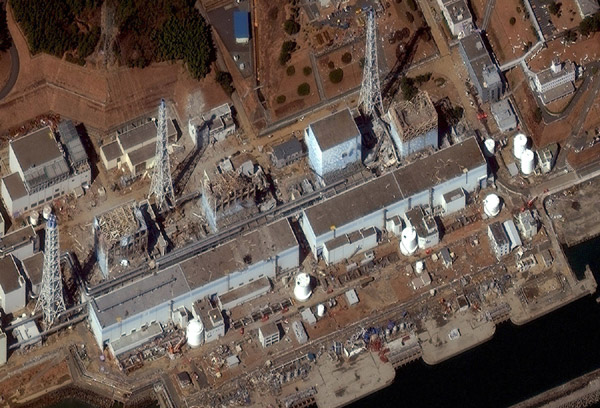flash
Japan lays power cable in race to stop radiation
(Agencies)
Updated: 2011-03-19 07:29
 |
Large Medium Small |
|
 (From R to L) Reactors No. 1 to 4 are seen at the Fukushima Daiichi Power Plant in Fukushima in this satellite image, taken and released by DigitalGlobe March 18, 2011. [Photo/Agencies] |
TOKYO – Exhausted engineers attached a power cable to the outside of Japan's tsunami-crippled nuclear plant on Saturday in a race to prevent deadly radiation from an accident now rated at least as bad as America's Three Mile Island incident in 1979.
Further cabling inside was under way before an attempt to restart water pumps needed to cool overheated nuclear fuel rods at the six-reactor Fukushima plant in northeastern Japan, 240 km (150 miles) north of Tokyo.
|
||||
It has also stirred unhappy memories of Japan's past nuclear nightmare -- the US atomic bombs dropped on Hiroshima and Nagasaki in 1945.
Working inside a 20 km (12 miles) evacuation zone at Fukushima, nearly 300 engineers were focused on trying to find a solution by restoring power to pumps in four of the reactors.
"TEPCO has connected the external transmission line with the receiving point of the plant and confirmed that electricity can be supplied," the plant's operator Tokyo Electric Power Co said in a statement.
Another 1,480 meters (5,000 feet) of cable are being laid inside the complex before engineers try to crank up the coolers at reactor No.2, followed by numbers 1, 3 and 4 this weekend, company officials said.
If that works it will be a turning point.
"If they are successful in getting the cooling infrastructure up and running, that will be a significant step forward in establishing stability," said Eric Moore, a nuclear power expert at US-based FocalPoint Consulting Group.
If not, there is an option of last resort under consideration to bury the sprawling 40-year-old plant in sand and concrete to prevent a catastrophic radiation release.
That method was used to seal huge leakages from the 1986 Chernobyl disaster.
Underlining authorities' desperation, fire trucks sprayed water overnight in a crude tactic to cool reactor No.3, considered the most critical because of its use of mixed oxides, or mox, containing both uranium and highly toxic plutonium.
Japan has raised the severity rating of the nuclear crisis to level 5 from 4 on the seven-level INES international scale, putting it on a par with the Three Mile Island accident in 1979, although some experts say it is more serious.
Chernobyl, in Ukraine, was a 7 on that scale.
| 分享按钮 |



